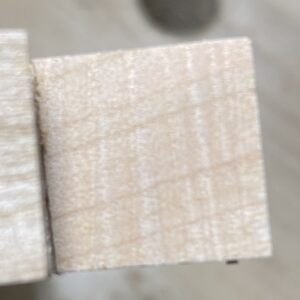I find it infinitely easier using the longer 14” cross cut than the 10” dovetail saw to cut dovetails. Anybody else? I mean is the kerf of the dt saw really that much cleaner because of the set? Convince me otherwise…
5/8 cherry. Of course thinner stock the DT saw wins
1 is DT
2 is Carcass

















Replies
“[Deleted]”
Actually, there was a time when all handsaws were rip. Up until the end of the 18th century, beginning of the 19th. Filing with rake and fleas was a more "recent" innovation.
I use a 14" Wenzloff carcase saw for everything except dovetails on 3/8 and thinner stock. A dovetail saw (filed rip) is supposed to be faster, and maybe is. But the crosscut carcase is plenty fast enough for me.
I wouldn't like to use a rip saw for crosscuts, but I'm very happy to use a crosscut saw for ripping -- in joinery. If I were ripping a 4 foot board with a handsaw I'd use a rip -- but I wouldn't do it by hand.
Agreed. I was just curious if others felt the same. The extra length of the LN crosscut saw makes it far easier to keep square. The “rough” kerf isn’t a problem for me even without paring.
Do you have evidence of this? Rip has always tended to be used for sawing with the grain, as in dovetails.
Regards from Perth
Derek
“[Deleted]”
Back in the 1970s, the only backsaws available were Nonpareil and other British makes. They were all crosscut, had too much set, and too many teeth. There was almost no one to sharpen them, and not much information on how to do it. The Independence Saw really was the first to offer good backsaws, followed by Adria and others.
That is not so about UK-make saws being crosscut. The Independence Tools saw was the work of Pete Taran and Patrick Leach in the mid 90’s. It was based on a 1830s English design. That alone should tell you that dovetail saws were filed rip over the past 100 years. It goes back further than that.
I have vintage saws by Groves, Nurse and others. These were the LN’s of their day. They were all filed rip. Think about it - why would a saw that aims to make a rip cut be filed crosscut?
Incidentally, I have both the IT and the LN dovetail saws. Both wonderful. I count Pete Taran among my friends, and have discussed saws with him on many an occasion.
Regards from Perth
Derek
No, these were just the saws made in the 1970s and sold here in the US. I don't know what else they made, but that's all they sold here. All crosscut, all with very tall plates, and wayyy too many teeth.
I never saw vintage backsaws in those days. There was the one and only Woodcraft store, and a couple of local flea markets.
I found a copy of the 1978 Woodcraft Catalog I saved and scanned. They had 3 on the Nonpareil backsaws, and that was it. We really are lucky today in comparison.
I still have that 8 inch backsaw. It was really frustrating trying to learn dovetails with that. I've thought about cutting new teeth, but the plate is was too deep for an 8 inch saw, and it's too short to use for anything else. And I have saws that are just way better.
“[Deleted]”
I prefer a shorter dovetail saw, 9-10".
I usually start a cut about an inch or two in from the toe. The teeth are around 15 tpi and cut fast. Two or two-and-a-half short pushes, and the average depth dovetail is reached. I do not need a long saw.
I also prefer shallow plates for dovetails. 1 1/2" - 2" is sufficient.
Below are two dovetail saws I made, one 15 tpi and the other thin kerf and 17tpi, along with a restored Nurse 16 tpi. All have teeth with a 5 degree rake.
Regards from Perth
Derek
Here's one I made about 10 years ago. 14ppi, 12 inches. Crosscut. I use it for dovetailing in 1" or more stock, and for dados with a guide batten.
There might be some truth to one saw behaving a bit better. I have more time behind my LN Dovetail saw than any other of my fine joinery saws. As such, that is the one I tend to reach for most frequetly. For a couple of years, I didn't have any fine joinery saw with cross cut teeth and used my dovetail saw. It worked just fine. The wood didn't explode.
This forum post is now archived. Commenting has been disabled